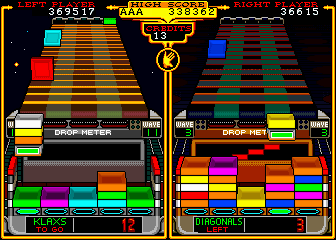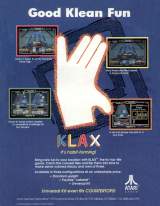

Klax © 1990 Atari Games.
The tiles klank, end over end, down the ramp. Catch them on the paddle, or they fall in the pit. Flip them from the paddle into the bins, matching the same-colored tiles horizontally, vertically, or diagonally. Each line of colored tiles is a Klax. When you've made a Klax, you hear a fanfare. When you complete a wave, the crowd cheers. Let a tile fall in the pit, and you hear a scream as it falls in. If you fail to complete a wave, the crowd is disappointed. Stay alive, complete the waves and don't drop any tiles!
Catch the tiles as they come to the end of the ramp on the paddle. Flip a tile into a bin by pressing the start/flip button. Pull the joystick forward to increase the speed of the closest tile as it klanks down the ramp. Push the joystick back and toss the top tile on the paddle back on the ramp and gain a little time.
The paddle can hold up to five tiles. As long as the green light is on below the paddle, you can pile more tiles on the paddle. When the red light appears, you must flip at least one tile in a bin or toss it back on the ramp before you can collect any more tiles. You can flip tiles into a bin as long as the green light is on below the bin.
To succeed in Klax, complete each wave while scoring points. Create a horizontal, vertical, or diagonal row of at least three tiles in the bins to make a Klax. You receive the most points for diagonals, less for horizontals and the least for verticals. When you create a Klax, the tiles in the Klax disappear to make room for more tiles in the bins.
Each wave has a different task to be completed, which is shown on the To Go Meter. This task could be making a certain number of Klaxes, points, or surviving a certain number of tiles. Complete the task before too many tiles drop in the pit and you complete the wave. When you complete a wave, you receive bonus points for the tiles remaining on the ramp, on the paddle, and any empty spaces in the bins. If you fail, you can start again at the same wave.
Klax does not have a clock for you to race against, but as your playing time increases, the tiles klank down the ramp faster and faster.
Waves : When you first enter the game, you can start at wave 1, 6, or 11. Wave 1 teaches you how to play the game and use the controls. At every fifth wave you can choose to play the next wave, the fifth wave beyond, or the tenth wave beyond.
Klax has five different types of waves and more than five different backgrounds. There are five waves per level, and one hundred waves to complete.
Each time you begin a wave, the To Go meter shows what kind of Klaxes or how many points you need to accumulate to complete the wave. The different types of waves are :
* Klaxes To Go, which are the easiest. Just create Klaxes horizontally, vertically or horizontally. Create enough Klaxes to complete the wave before you drop too many tiles in the pit.
* Tiles To Go requires you to survive a certain number of tiles. Create Klaxes in any of the three ways to collect points and to clear the bins to hold more tiles.
* Points To Go requires you to make a certain number of points. Create Klaxes to collect points but make diagonals, four- or five-of-a-kind Klaxes, and simultaneous Klaxes for higher points.
* Diagonals To Go requires you to create diagonals. Create Klaxes in any way to collect points; but only the correct number of diagonals will complete the wave.
* Horizontals To Go requires you to create horizontals. Only horizontal Klaxes will complete the wave; but you can still create Klaxes vertically and diagonally to collect points.
There are several bits of information on the screen. These include the:
* To Go Meter, which continuously calculates the number of Klaxes, tiles, points, diagonals or horizontals still required to complete the wave. The number depends on the type of wave you are playing.
* Drop Count, which shows the number of dropped tiles. The drop count is continuously calculated. When the number of tiles dropped is reached, the wave is over.
* High Score, which shows the highest score to date, regardless of the number of continues that player had.
* Wave Indicator, which shows what wave you are playing.

Game ID: 136075
Main CPU: Motorola 68000 (@ 7.15909 Mhz)
Sound Chips: OKI6295 (@ 6.779 Khz)
Players: 2
Control: 8-way joystick.
Buttons: 1
Even if the titlescreen says 1989, Klax was released in February 1990.
550 dedicated upright were produced in the USA and 451 in Ireland for European distribution. The selling price was $1,895.
500 dedicated cabaret were produced in the USA and 306 in Ireland. The selling price was $1,695.
4,800 conversion kits were produced in the USA and 958 in Ireland. The selling price was $895.
Dave Akers originally programmed this in Amiga Basic, then ported it line-by-line to C. It was written in just a few weeks on "Escape From the Planet of the Robot Monsters" hardware.

The prototype versions have different graphics, only one background with different palettes, and uglier tiles. Tiles sometimes look wrongly placed. When you throw the tile back, it's flying much further (approx. 6 seconds instead of 1). This version has 'By MSP and DSA' on the title screen.
| 3 Vertical Klax | 50 points. |
| 4 Vertical Klax | 10,000 points. |
| 5 Vertical Klax | 15,000 points. |
| 3 Horizontal Klax | 1,000 points. |
| 4 Horizontal Klax | 5,000 points. |
| 5 Horizontal Klax | 10,000 points. |
| 3 Diagonal Klax | 5,000 points. |
| 4 Diagonal Klax | 10,000 points. |
| 5 Diagonal Klax | 20,000 points. |
| Large 'X' Klax | 80,000 points. |
| Big Sandwich | 100,000 - 440,000 points. |
Designer, Animator, Project Leader: Mark Stephen Pierce (MSP)
Software Design, Programming: David Akers (David S. Akers) (DSA)
Hardware Design & Implementation: Pat McCarthy (Pat McCarthy) (PMC), Tim Hubberstey (TJH)
System Software: John Salwitz (JFS)
Audio: Brad Fuller
Technician: Farrokh Khodadadi (FRK)
Marketing Manager: Jerry Momoda
Team Supervisor: John Ray (RAY)
CONSOLES:
NEC TurboGrafx-16 (1990) "Klax [Model TTGX20001]"
 Sega Mega Drive (1990) by Tec Toy
Sega Mega Drive (1990) by Tec Toy
Sega Mega Drive (1990)
Atari 2600 (1990) "Klax [Model CX26192]"
Nintendo NES (1990)
Amstrad GX4000 (1990)
NEC PC-Engine (aug.10, 1990) "Klax [Model TG90001]"
Sega Genesis (sept.6, 1990)
Sega Mega Drive (sept.7, 1990) "Klax [Model T-14063]"
Nintendo Famicom (dec.14, 1990) "Klax [Model HFC-V6]"
Sega Master System (1991) "Klax [Model 301040]"
Atari 7800 (1992) "Klax [Model CX7888]" : unreleased
Sony PlayStation (sept.30, 1999) "Arcade Party Pak [Model SLUS-00952]"
Sony PlayStation (feb.23, 2001) "Arcade Party Pak [Model SLES-02339]"
Atari 7800 (2002) by ResQsoft Productions
Sony PS2 (nov.18, 2003) "Midway Arcade Treasures [Model SLUS-20801]"
Microsoft XBOX (nov.24, 2003) "Midway Arcade Treasures"
Nintendo GameCube (dec.18, 2003) "Midway Arcade Treasures [Model DOL-GAKE-USA]"
Microsoft XBOX (feb.6, 2004) "Midway Arcade Treasures"
Sony PS2 (feb.6, 2004) "Midway Arcade Treasures [Model SLES-51927]"
HANDHELDS:
Atari Lynx (1990) "Klax [Model PA2031]"
Nintendo Game Boy (1990) "Klax [Model DMG-KLA]"
Nintendo Game Boy (1991)
Nintendo Game Boy (jul.1991) "Klax [Model DMG-KX-USA]"
Sega Game Gear (1992)
Nintendo Game Boy Color (1999) "Klax [Model CGB-ALXP-EUR]"
Nintendo Game Boy Color (apr.1999) "Klax [Model CGB-ALXE-USA]"
Nintendo GBA (aug.16, 2005) "2 Games in One! Marble Madness + Klax [Model AGB-B68E-USA]"
Nintendo GBA (sept.16, 2005) "2 Games in One! Marble Madness + Klax [Model AGB-B68P-EUR]"
Sony PSP (dec.13, 2005) "Midway Arcade Treasures Extended Play [Model ULUS-10059]"
Sony PSP (feb.24, 2006) "Midway Arcade Treasures Extended Play [Model ULES-00180]"
COMPUTERS:
MSX (1989)
BBC Micro(1990)
Commodore C64 (1990)
Amstrad CPC (1990)
Amstrad CPC+ (1990)
Commodore Amiga (1990)
Atari ST (1990)
Sam Coupe (1990) by Domark
Sinclair ZX Spectrum (1990)
Sharp X68000 (dec.14, 1990) by Hudson
NEC PC 8801 (1990) by Hudson
NEC PC 9801 (1990) by Hudson
PC [MS-DOS, 3.5"] (1992)
PC [MS Windows, CD-ROM] (aug.27, 2004) "Midway Arcade Treasures"
PC [MS Windows, CD-ROM] (nov.23, 2004) "Midway Arcade Treasures"
Game's manual.
Game's picture.
Game's ROMs.
Game's screenshots.
See goodies section.